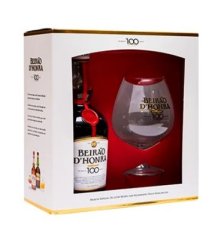Licor Beirão D'Honra 100
The Beirão d'Honra, which was born as a tribute to J. Carranca Redondo and with the intention of being a limited edition, is a recipe enriched with aged grape brandy. The recipe is unique, the flavor is captivating, and it is ideal for unique and memorable moments: word of honor. As for consumption, unlike Licor Beirão, Beirão d'Honra should preferably be enjoyed in a Balloon Glass and neat - without ice.
Beirao dhonra (by honour in English) is a symbolic tribute that intends to honour the memory of the patriarch of this family and the "father" of Licor Beirao. This is a special recipe, created by the second and third generation of Redondo family and the "father" of Licor Beirao.
Food pairing
Digestive
Alcoholcontent
30% vol
History
The story goes like this: at the end of the 19th century, a Port Wine salesman, passing through Lousã, fell in love with the daughter of a pharmacist, and they ended up getting married. In the pharmacy, apart from the usual drugs, they sold “natural liqueurs” which were made with secret ancient formulae.
Meanwhile, a law forbidding the claim of medical properties for liqueurs came into force. The young man from the North took this opportunity and started producing the nectars independently, with the same craftsman’s processes, in a small factory.
But the name Licor Beirão did not come at random. In 1929 a Congress on the Beirão region took place in Castelo Branco, and that’s when the liqueur was baptized Beirão, as a tribute to the gathering. The problems caused by World War II caused the sale of the factory, in 1940, to a young man from Lousã, José Carranca Redondo, who had worked there for some time. In his twenties, and then married, he decided to invest his savings and bought the house and the secret, dedicating himself body and soul to the liqueur that started to be produced by his wife.
From that moment on, sales started growing and it became a liqueur of great success.
Licor Beirão is currently produced in Quinta do Meiral, in Lousã (district of Coimbra, in Portugal). With more than 12 hectares, some of the plants and aromatic seeds are produced here allowing greater quality control. The remaining ingredients are brought from distant zones like India, Sri Lanka, Brazil and Turkey, among others.


